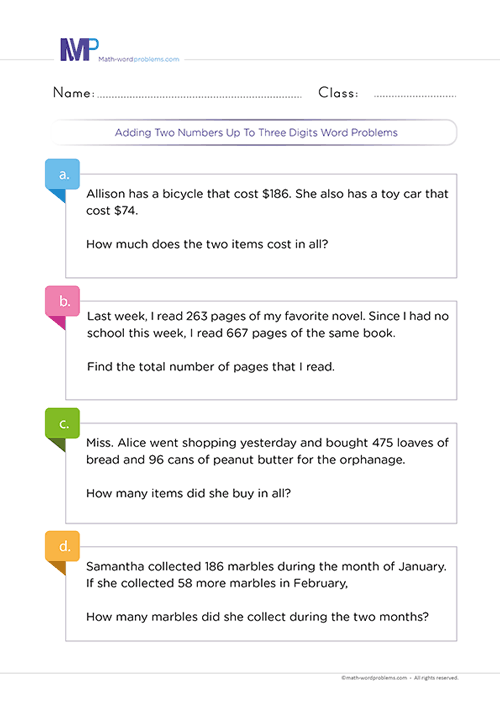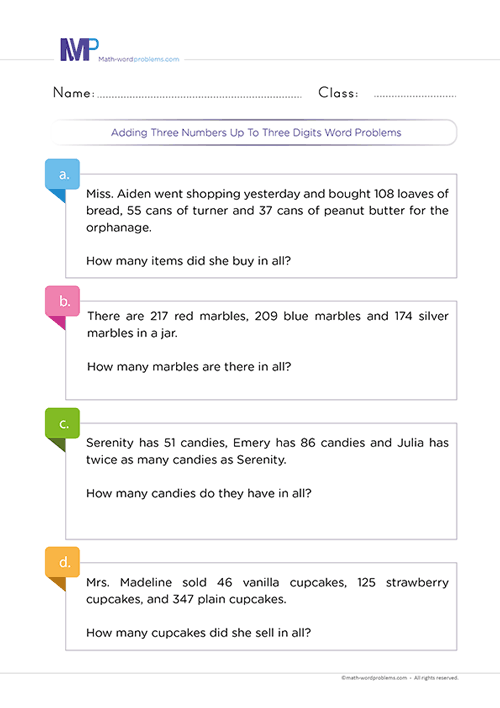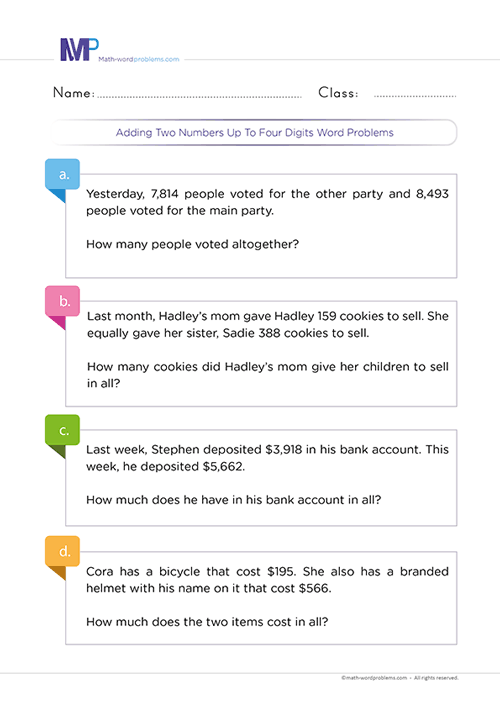 How to effortlessly add two numbers up to three digits word problems
How to effortlessly add two numbers up to three digits word problems

- INTRODUCTION
- Step 1 Identify
- Step 2 STRATEGIZE
- Step 3 SET UP
- Step 4 PROVIDE A SOLUTION
- Step 5 CHECK YOUR WORK
Get more contents on this skill...
Your 3rd Graders will learn how to effortlessly add two numbers up to three digits word problems only in this fun, unique resource. You will find a lot of exciting techniques here that will help your kids to grasp a deep-structure analysis of addition word problem-solving skills.
Given that kids often find it challenging to solve multi-digit addition word problems, we will offer them technical ways to tackle and quickly translate any inconsistent addition word problems into a solvable maths equation, thereby developing outstanding addition problem-solving abilities.
Steps to solve addition of two numbers up to three digits word problems
Below are quick steps to solve addition of two numbers up to three digits word problems, aimed to uplift and improve your kids' talented brains to arrive at concrete results effortlessly.
Besides, our four-step problem-solving fun design will teach kids how to effortlessly add two numbers up to three digits word problems and transform any information in an addition problem into a meaningful mathematics equation.
Now, follow along as we solve some real-life examples of addition of two numbers up to three digits word problems.
Step 1 IDENTIFY THE PROBLEM
To identify the problem,
- First, you have to read the problem well to understand it.
- Secondly, identify and underline statements that are related.
- Thirdly, reread the question and identify significant numbers and keywords in the problem.
- For instance, if it is addition word problems, these are the most important keywords that you’ll see: add, plus, more, total, increase, together/all together, combined, sum, grow, join, both, in all, altogether, how many in all, how much, and, etc.
Note: learners should understand that it would be best not to rely entirely on keywords alone because a particular keyword can have different meanings in different word problems.
In that case, you need to read the question very well to understand the situation the word problem describes. After reading, you will also find out if the problem makes sense first before determining which operation you need to use.
Step 2 STRATEGIZE AND DETERMINE THE OPERATIONS
Now, ask yourself, “how can I solve this problem?”
This step encourages learners to read the word problem and retell it in a story form using their own words.
Furthermore, since each word problem may require a different scheme to solve, these key points below will enable young math learners to tackle any scheme a word problem may present.
- First, the keyword in the word problem will help clarify the operation that you need to carry out.
- However, relying on keywords alone to solve word problems is limited. So, it is for this reason that you have to read the word problem to understand the situation that the problem is describing and hence identify the problem type and relational statement, which, together with the keyword(s) found in the problem, will determine the accurate math operation needed.
Step 3 SET UP A NUMBER SENTENCE AND AN EQUATION
- After knowing which operation you will perform from step 2 above, construct short phrases representing the information given in the word problem.
- These short phrases or sentences represent the vital information that makes it easier to solve the word problem. In order words, it is like a diagram of the word problem.
- Now, you can deduce a solvable maths equation to represent the information given in the phrases you constructed above.
Step 4 SOLVE THE PROBLEM
After writing down the maths equation, you can solve the problem using any addition method of your choice, preferably the column method. Most importantly, always add the unit of measurement to the final result
Step 5 VERIFY YOUR ANSWER
Finally, check your work to make sure that your answer is correct. For instance, since you are dealing with only numbers and not algebraic expressions, it is good to use reasonableness by estimation to see if your answer makes sense.
So, if you estimate and the answer is close to the one you have, then your answer is correct. However, if your answer is outrageous, you must go back to step one and start again.
Examples of how to add two numbers up to three digits word problems
Example One
Step 1:After reading the problem and underlining the relational statement, the important numbers you’ll find are $120 and $78. Also, the keyword you will find in the word problem is “in all.”
Step 2:Next, ask yourself, “How can I solve this problem?”
First, what is the problem trying to say?
The problem is that you have two things with different prices and want to know the total amount of money those two prices can be if you join them together.
Now, the question should be:- which operation can join two similar things into one?
From the situation that the problem is describing, from retelling the problem in your own words, and from the keyword in the word problem, all point to an addition operation.
Step 3:Construct short phrases representing vital information in the word problem.
Also, write down a solvable maths equation to represent the information given in the sentence that is in bold below.
- Cost of the bicycle = $120
- Cost of the toy car = $78
- Therefore, the total cost of the items = the cost of the bicycle + the cost of the toy car.
→ $120 + $78 = ?
Step 4: From step 3 above, stack the values in the equation you formed so that their place values should line up. Then, add the values using any addition method, preferably column addition. Also, always include the unit of measurement in the final result.
So, the two items cost $198 in all.
Step 5: Finally, check your work to ensure your answer is correct. For instance, since you are dealing with only numbers and not algebraic expressions, it is good to use reasonableness by estimation to see if your answer makes sense.
So, if you estimate and the answer is close to the one you have, then your answer is correct. However, if your answer is outrageous, you must go back to step one and start again.
Example Two
Step 1:After reading the problem and underlining the relational statements, you’ll find the important numbers 142 and 219. Also, the keyword in the word problem is “how many.”
Step 2:Next, ask yourself, “How can I solve this problem?”
First, what is the problem trying to say?
The problem is that Jonas gave his sister and his cousin a certain number of stickers each from the number of stickers he had. Also, the problem wants to know the number of stickers Jonas gave to his cousin and sister.
Now, the question should be: which operation can join two similar things into one?
From the situation that the problem is describing, from retelling the problem in your own words and from the keyword in the word problem, you need to perform an addition operation.
Step 3: Construct short phrases representing vital information in the word problem.
Also, write down a solvable maths equation to represent the information given in the sentence that is in bold below.
- Number of stickers that he gave to his cousin = 142,
- Number of stickers that he gave his sister = 219,
- Therefore, the number of stickers that he gave to his cousin and sister = the number of stickers that he gave to his cousin + the number of stickers that he gave his sister;
→ 142 + 219 = ?
Step 4: From step 3 above, stack the values in the equation you formed so that their place values should line up. Then, add the values using any addition method, preferably column addition. Also, always add the unit of measurement to the final result.
So, he gave 361 stickers to his cousin and sister.
Step 5: Finally, check your work to ensure your answer is correct. For example, since you are dealing with only numbers and not algebraic expressions, it is good to use reasonableness by estimation to see if your answer makes sense.
So, if you estimate and the answer is close to the one you have, then your answer is correct. However, if your answer is outrageous, you must go back to step one and start over again.





